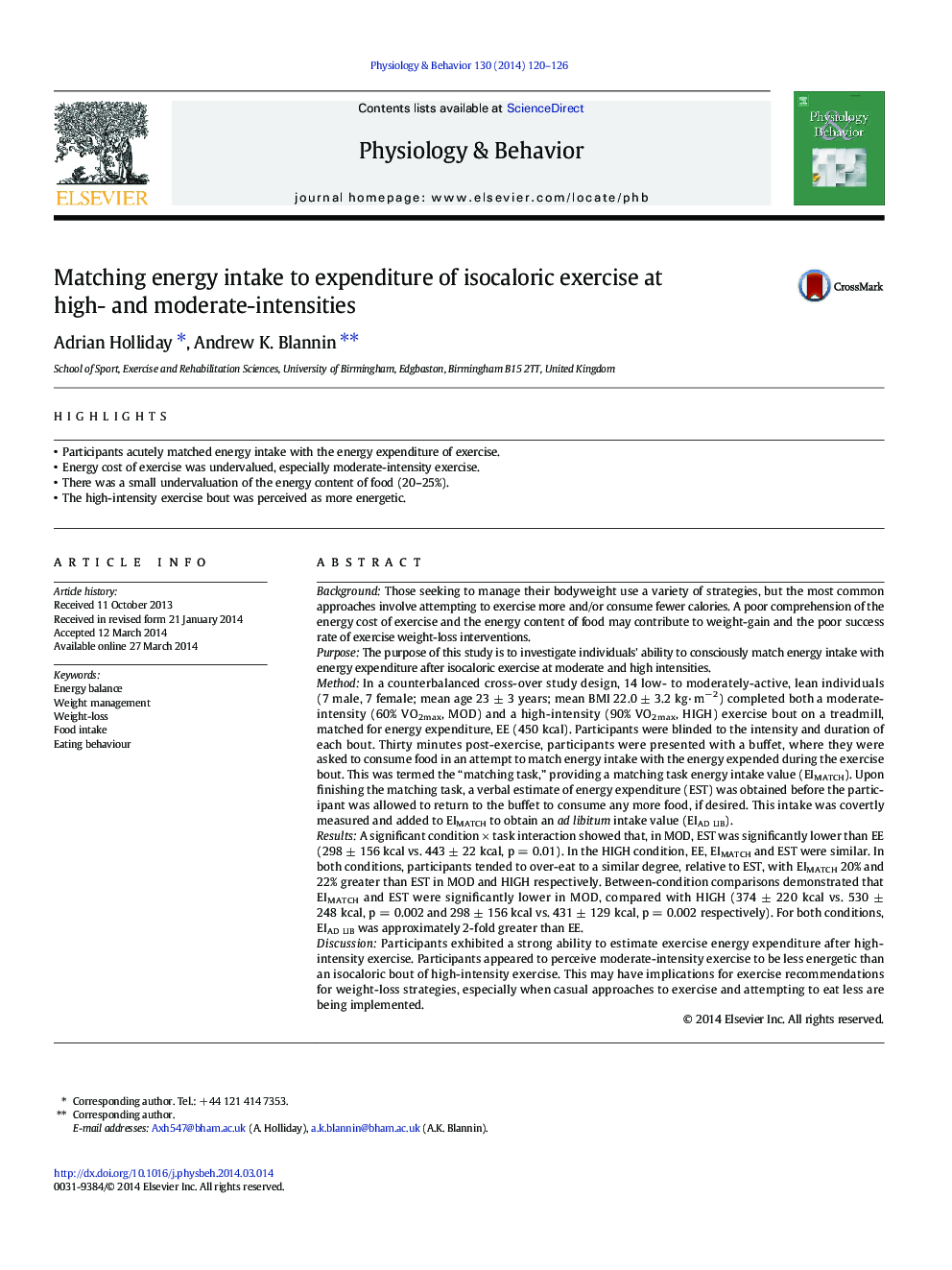| کد مقاله | کد نشریه | سال انتشار | مقاله انگلیسی | نسخه تمام متن |
|---|---|---|---|---|
| 5924220 | 1571187 | 2014 | 7 صفحه PDF | دانلود رایگان |
- Participants acutely matched energy intake with the energy expenditure of exercise.
- Energy cost of exercise was undervalued, especially moderate-intensity exercise.
- There was a small undervaluation of the energy content of food (20-25%).
- The high-intensity exercise bout was perceived as more energetic.
BackgroundThose seeking to manage their bodyweight use a variety of strategies, but the most common approaches involve attempting to exercise more and/or consume fewer calories. A poor comprehension of the energy cost of exercise and the energy content of food may contribute to weight-gain and the poor success rate of exercise weight-loss interventions.PurposeThe purpose of this study is to investigate individuals' ability to consciously match energy intake with energy expenditure after isocaloric exercise at moderate and high intensities.MethodIn a counterbalanced cross-over study design, 14 low- to moderately-active, lean individuals (7 male, 7 female; mean age 23 ± 3 years; mean BMI 22.0 ± 3.2 kg·mâ 2) completed both a moderate-intensity (60% VO2max, MOD) and a high-intensity (90% VO2max, HIGH) exercise bout on a treadmill, matched for energy expenditure, EE (450 kcal). Participants were blinded to the intensity and duration of each bout. Thirty minutes post-exercise, participants were presented with a buffet, where they were asked to consume food in an attempt to match energy intake with the energy expended during the exercise bout. This was termed the “matching task,” providing a matching task energy intake value (EIMATCH). Upon finishing the matching task, a verbal estimate of energy expenditure (EST) was obtained before the participant was allowed to return to the buffet to consume any more food, if desired. This intake was covertly measured and added to EIMATCH to obtain an ad libitum intake value (EIAD LIB).ResultsA significant condition Ã task interaction showed that, in MOD, EST was significantly lower than EE (298 ± 156 kcal vs. 443 ± 22 kcal, p = 0.01). In the HIGH condition, EE, EIMATCH and EST were similar. In both conditions, participants tended to over-eat to a similar degree, relative to EST, with EIMATCH 20% and 22% greater than EST in MOD and HIGH respectively. Between-condition comparisons demonstrated that EIMATCH and EST were significantly lower in MOD, compared with HIGH (374 ± 220 kcal vs. 530 ± 248 kcal, p = 0.002 and 298 ± 156 kcal vs. 431 ± 129 kcal, p = 0.002 respectively). For both conditions, EIAD LIB was approximately 2-fold greater than EE.DiscussionParticipants exhibited a strong ability to estimate exercise energy expenditure after high-intensity exercise. Participants appeared to perceive moderate-intensity exercise to be less energetic than an isocaloric bout of high-intensity exercise. This may have implications for exercise recommendations for weight-loss strategies, especially when casual approaches to exercise and attempting to eat less are being implemented.
Journal: Physiology & Behavior - Volume 130, 10 May 2014, Pages 120-126
